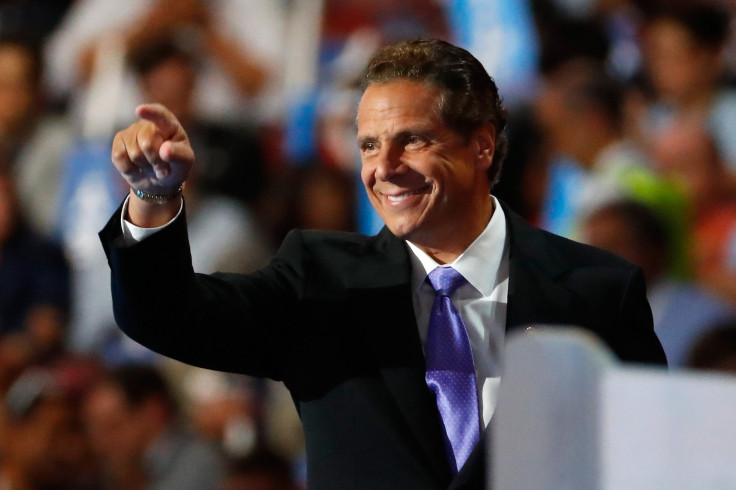Andrew Cuomo Administration Now Questions General Electric Move To End Hudson River Cleanup

New York Gov. Andrew Cuomo’s administration this week said General Electric had not adequately cleaned up its pollution from the Hudson River, adding the voice of a powerful state government to an environmental campaign against the corporate giant. The move was an abrupt reversal for the Democratic governor, who less than a year ago seemed to suggest he would support allowing the company to shut down its dredging operations.
Cuomo was facing intensifying pressure to act, after a 2015 International Business Times series documented how GE and its employees had pumped more than $466,000 into groups linked to him. That was on top of the $366,000 worth of GE campaign contributions that flowed to New York’s federal lawmakers in the last three election cycles. Cuomo was offering GE economic development subsidies, yet not demanding the company remove all of the polychlorinate byphenols GE facilities had leaked into New York's largest river during the mid-20th century. Those chemicals — which are a suspected carcinogen — ended up creating one of the largest superfund sites in the United States.
GE's 2015 decision to halt its cleanup operations was blessed by the Environmental Protection Agency under its original cleanup agreement with the company, even though environmental groups assert that more pollution has been discovered since that deal was forged in 2006. Now, Cuomo’s administration appears to be taking the environmental groups’ side.
“While EPA’s work overseeing the General Electric remedial dredging project has improved the Hudson River, the work is not done,” wrote Basil Seggos, the head of Cuomo’s Department of Environmental Conservation, in a letter to the Environmental Protection Agency. Seggos added that because of persistent pollution, the state may no longer agree with the EPA that its original cleanup agreement “abates the significant threat to human health and the environment posed by GE’s disposal of PCBs in the river."
GE did not indicate it was willing to continue removing PCBs from the river.
“GE addressed 100 percent of the PCBs targeted by EPA, removing twice the volume of PCBs as had been anticipated,” said a statement from the company. “Dredging was completed in October 2015. EPA declared the project a success and said no additional dredging is warranted.”
The EPA issued a statement saying that this is the "beginning of a robust, open and transparent process for the second of what will be a series of reviews, conducted every five years, of the Hudson dredging project."
The sudden aggressive posture by the Cuomo administration contrasts with its stance in 2015. Back then, after IBT’s initial report on GE campaign cash and as environmental groups pushed him to intervene, Cuomo declined to take a position on whether GE should remove more of the PCBs. He said only that GE should “follow the law and the agreements that have been made” and that “I know there are claims for [GE] to do more above and beyond that.” He added, “I haven’t really looked into that.”
At the time, Cuomo was courting General Electric to move its headquarters to New York, and his administration did not make a subsidy package contingent on the company removing all the PCBs. Cuomo was slammed by, among others, the New York Times editorial board, which called on him to start “standing up to one of his most generous corporate donors.”
Over the course of the next year, two federal agencies asked the Obama adminstration to use its power to delay the end of the cleanup. But the third Hudson River trustee, Cuomo’s Department of Environmental Conservation, did not join that call. Then the Securities and Exchange Commission helped GE quash a shareholder resolution — backed by New York’s public pension system — that would have compelled GE to produce a detailed analysis of how it could fully address its pollution.
GE ultimately decided against moving its headquarters to New York, instead moving it to Boston. There, state and local officials offered the conglomerate $145 million worth of taxpayer subsidies just as the company was fighting a federal proposal to force it to clean up its similar PCB pollution on the Housatonic River. Massachusetts Republican Gov. Charlie Baker — whose election campaign was backed by a group that received $125,000 from GE — declared that "there's no connection” between offering taxpayer subsidies and compelling the company to clean up its pollution.
Though New York lost out on GE’s headquarters, lawmakers and environmental groups this week celebrated the Cuomo administration’s move to challenge the company.
“For more than a year, I, along with other elected officials and environmental advocacy groups, have sounded the alarm about GE’s insufficient cleanup of PCBs in the Hudson River, which is estimated to be only 65 percent complete,” said State Sen. Brad Hoylman, a Democrat. “The polluter must pay. GE treated the Hudson River like its own personal dumping ground for decades. It’s essential that the EPA respond to the concerns raised today by New York State and force GE to finish their cleanup of the Hudson River.”
© Copyright IBTimes 2025. All rights reserved.






















